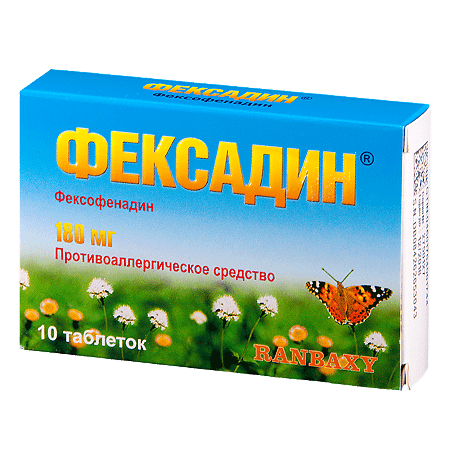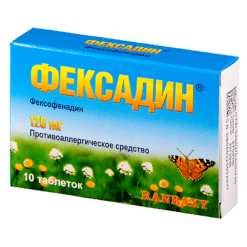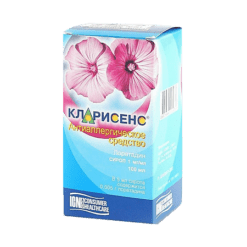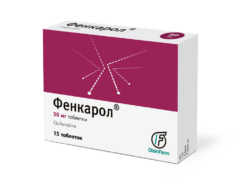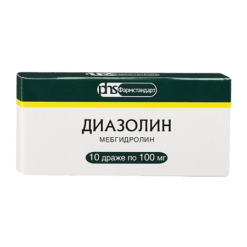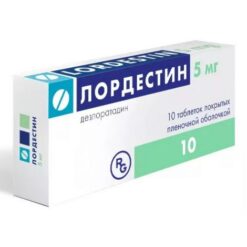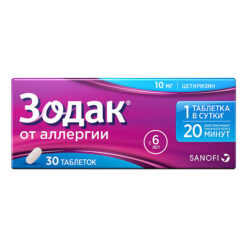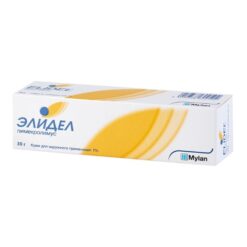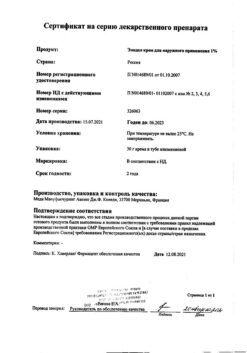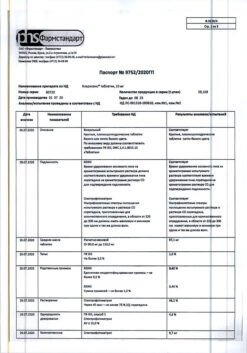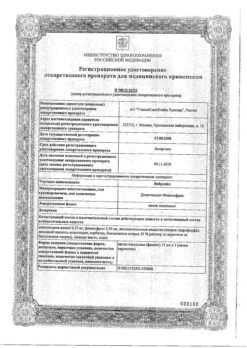No products in the cart.
Description
Pharmacodynamics.
Fexophenadine hydrochloride is a blocker of H1-histamine receptors with practically no sedative action. Fexophenadine is the pharmacologically active metabolite of terfenadine.
The antihistamine effect of the drug appears 1 hour after ingestion, reaches its maximum after 6 hours and lasts for 24 hours. After 28 days of use there is no development of tolerance. There is a linear dose-response relationship when oral doses of 10 mg to 130 mg are administered. A dose of 120 mg is sufficient for 24-hour effectiveness of the drug (for allergic rhinitis). In the dose up to 240 mg the drug does not cause changes in the QT interval.
Pharmacokinetics
Fexofenadine hydrochloride is rapidly absorbed from the gastrointestinal tract after oral administration, time to reach maximum concentration (TSmax) is 1-3 hours. The average value of maximum concentration (Cmax) after a dose of 120 mg is 289 ng/ml, and after a dose of 180 mg – about 494 ng/ml. Plasma protein binding is 60-70% (predominantly with albumin and alpha1-glycoprotein). Does not penetrate the blood-brain barrier. Fexofenadine undergoes partial (5% of the dose) metabolism.
The excretion is biphasic. The elimination half-life (T1/2) after repeated administration is 11 to 15 hours. In patients with moderate (creatinine clearance 41-80 ml/min) and severe (11-40 ml/min) renal insufficiency T1/2 is increased by 59 and 72 % accordingly; in patients on hemodialysis T1/2 is increased by 31 %. Pharmacokinetics with single and repeated administration of fexofenadine (up to 120 mg twice a day) is linear.
It is eliminated mainly (80%) in bile, up to 10% of the taken dose is excreted unchanged in the urine.
Indications
Indications
Seasonal allergic rhinitis: sneezing, itching, rhinitis, redness of the eye mucosa and other symptoms of hay fever – tablets, 120 mg;
Chronic idiopathic urticaria: redness, itching and other symptoms of urticaria – tablets, 180 mg.
Pharmacological effect
Pharmacological effect
Pharmacodynamics.
Fexofenadine hydrochloride is an H1-histamine receptor blocker with virtually no sedative effects. Fexofenadine is a pharmacologically active metabolite of terfenadine.
The antihistamine effect of the drug appears 1 hour after administration, reaches a maximum after 6 hours and continues for 24 hours. After 28 days of use, no development of tolerance is observed. When administered orally in doses ranging from 10 mg to 130 mg, there is a linear dose-response relationship. For 24-hour effectiveness of the drug (for allergic rhinitis), a dose of 120 mg is sufficient. At a dose of up to 240 mg, the drug does not cause changes in the QT interval.
Pharmacokinetics
Fexofenadine hydrochloride after oral administration is rapidly absorbed from the gastrointestinal tract, the time to reach maximum concentration (TCmax) is 1-3 hours. The average maximum concentration (Cmax) after taking a dose of 120 mg is 289 ng/ml, and after taking a dose of 180 mg is approximately 494 ng/ml. Bonding with plasma proteins is 60–70% (mainly with albumin and alpha1-glycoprotein). Does not penetrate the blood-brain barrier. Fexofenadine undergoes partial (5% of the dose) metabolism.
Elimination is two-phase. The half-life (T1/2) after repeated doses is from 11 to 15 hours. In patients with moderate (creatinine clearance 41–80 ml/min) and severe (11–40 ml/min) renal failure, T1/2 increases by 59 and 72%, respectively; in patients on hemodialysis, T1/2 increases by 31%. Pharmacokinetics with single and repeated use of fexofenadine (up to 120 mg twice a day) is linear.
It is excreted predominantly (80%) with bile, up to 10% of the dose taken is excreted unchanged in the urine.
Special instructions
Special instructions
In older patients or patients with hepatic impairment, fexofenadine should be used with caution due to lack of data. It is recommended that the time interval between taking fexofenadine hydrochloride and antacids containing aluminum or magnesium hydroxide is 2 hours.
Impact on the ability to drive a car and perform work requiring concentration
When taking the drug Fexadin, it is possible to perform work that requires a high concentration of attention and speed of psychomotor reactions (with the exception of people who have a non-standard reaction to drugs). Thus, before starting to perform these works (driving vehicles, operating machinery), you must first check your individual reaction to the drug.
Active ingredient
Active ingredient
Fexofenadine
Composition
Composition
Each film-coated tablet contains:
active ingredient:
Fexofenadine hydrochloride 120 mg or 180 mg
For tablets 180 mg
Auxiliary ingredients:
Croscarmellose sodium – 30.00 mg, microcrystalline cellulose – 266.13 mg, gelatinized starch – 87.00 mg, colloidal silicon dioxide – 21.00 mg, povidone – 9.0 mg, magnesium stearate – 6.00 mg, purified water * – up to 600.00 mg.
Film casing:
Opadry pink dye (OY-54957) – 23.40 mg: (hypromellose, titanium dioxide, macrogol-400, red iron oxide dye (CI No. 77491), purified water*.
Printing ink:
Opacode S-1-17823 black – q.s.:
glazed shellac-45% (20% etherified) in ethanol, black iron oxide dye, N-butyl alcohol, propylene glycol, isopropanol, ammonium hydroxide 28%.
(*-evaporates during the production process).
Pregnancy
Pregnancy
Possibly if the expected effect of therapy exceeds the potential risk to the fetus.
Breastfeeding should be stopped during treatment.
Contraindications
Contraindications
Hypersensitivity to any of the components of the drug, pregnancy, lactation, children (up to 12 years), chronic renal failure.
Side Effects
Side Effects
Headache, drowsiness, nausea, dyspepsia, dizziness.
Rarely (less than 1 case in 1000 prescriptions): feeling tired, insomnia, nervousness, sleep disturbance.
In some cases: skin rash, urticaria, itching, other hypersensitivity reactions: angioedema, shortness of breath.
Interaction
Interaction
When used together with erythromycin or ketoconazole, the plasma concentration of fexofenadine increases by 2-3 times.
There is no significant effect on increasing the QT interval.
Taking aluminum or magnesium-containing antacids 15 minutes before taking fexofenadine leads to a decrease in the bioavailability of the latter (the time interval between their administration should be at least 2 hours).
Does not interact with omeprazole.
Overdose
Overdose
Symptoms: dizziness, drowsiness and dry mouth.
In case of overdose, standard measures are recommended to remove unabsorbed drug from the gastrointestinal tract.
Symptomatic and supportive therapy is recommended.
Hemodialysis is ineffective.
Storage conditions
Storage conditions
In a dry place, at a temperature not exceeding 25 °C
Shelf life
Shelf life
3 years
Manufacturer
Manufacturer
Sun Pharmaceutical Industries Ltd, India
Additional information
| Shelf life | 3 years |
|---|---|
| Conditions of storage | In a dry place, at a temperature not exceeding 25 °C |
| Manufacturer | Sun Pharmaceutical Industries Ltd, India |
| Medication form | pills |
| Brand | Sun Pharmaceutical Industries Ltd |
Other forms…
Related products
Buy Fexadine, 180 mg 10 pcs with delivery to USA, UK, Europe and over 120 other countries.

